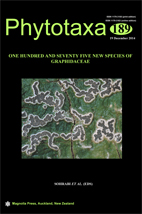Abstract
Graphidaceae is the largest family of tropical crustose lichens, with nearly 2,400 known species, and exhibits a large diversity of ascoma morphologies. Ascomata that open by triangular marginal lobules that become recurved to form geaster-like fruiting bodies, so-called chroodiscoid ascomata, were recently shown to have evolved independently several times within the family. A special type of such ascomata is the gyrotremoid form in which the hymenium and excipulum are organized in concentric rings. In the present study, we address the phylogenetic position of two chroodiscoid species collected in Thailand that form aggregate or gyrotremoid, chroodiscoid ascomata, using a molecular phylogeny of nuclear LSU and mitochondrial SSU rDNA sequences of 92 Graphidaceae. Our morphological, chemical and phylogenetic analyses show that one species is an undescribed species in the genus Astrochapsa, here newly described as A. kalbii Poengsungnoen, Lücking & Lumbsch, with a unique, gyrotremoid ascoma morphology. The second species belongs in the recently established genus Nitidochapsa, which is a close relative of Ocellularia, and is here described as new species N. siamensis Poengsungnoen, Lücking & Lumbsch. Based on these findings, three further new combinations are proposed in the genus Nitidochapsa, viz. N. aggregata (Hale) Poengsungnoen, Lücking & Lumbsch, N. phlyctidea (Vain.) Lücking & Lumbsch, and N. stictoides (Leight.) Tehler, Lücking & Lumbsch. A key to all five species is presented.

